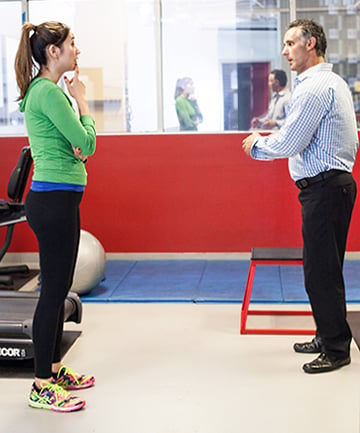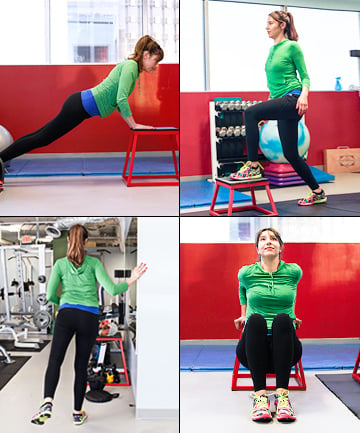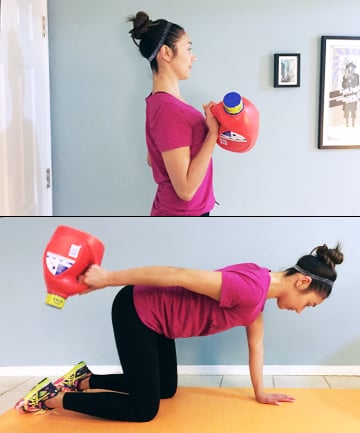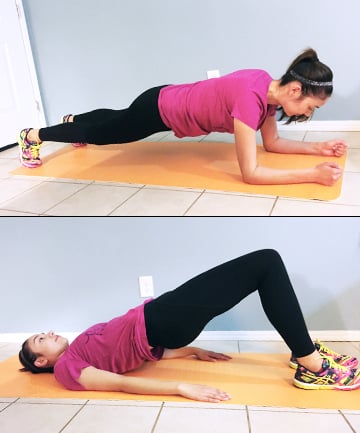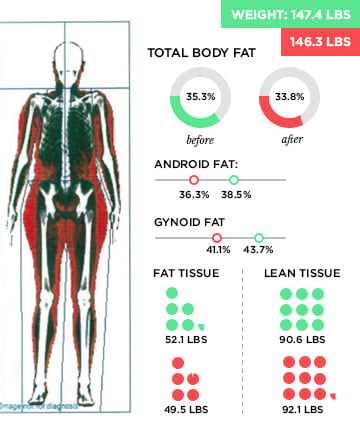Armed with my stats, I paid bodybuilder and trainer Dr. Robert Pomahac, founder of MaxHealth LA, a visit to create a 10-minute exercise regimen designed to tone my lower belly, arms and butt.
He prescribed a workout plan that interspersed resistance training with cardiovascular training. "The more muscle you have, the better your body can burn fat," Pomahac explained. To provide a "break" between resistance sets -- and make sure I didn't keel over from doing back-to-back resistance moves after not having picked up a weight in months -- he had me jump rope. "Then you're incorporating your cardiovascular -- skipping rope -- as a break component from the resistance training to give yourself a bit of a time to recuperate and to make sure that you're doing the muscle training properly."
I had to try to reach 80 percent of my maximum heart rate (calculated by subtracting your age from 220 and then multiplying that number by .80) when doing the routine. Here's what the plan looked like in its entirety:
Lunges (15 reps per leg)
Jump rope for 30 seconds
Close-grip pushup (15 reps)
Jump rope for 30 seconds
Wide pushup
Jump rope for 30 seconds
Bicep curl (15 reps per arm)
Jump rope for 30 seconds
Leg lift (15 per leg)
Jump rope for 30 seconds
Stool step-ups (15 reps per leg)
Jump rope for 30 seconds
Seated isometric ball squeeze (15 reps using a throw pillow as a substitute)
Jump rope for 30 seconds
Triceps dips (15 reps)
Looks pretty straightforward, right? So, how did I fair with my 10-minute routine (and should you try it, too)?
I had to try to reach 80 percent of my maximum heart rate (calculated by subtracting your age from 220 and then multiplying that number by .80) when doing the routine. Here's what the plan looked like in its entirety:
Lunges (15 reps per leg)
Jump rope for 30 seconds
Close-grip pushup (15 reps)
Jump rope for 30 seconds
Wide pushup
Jump rope for 30 seconds
Bicep curl (15 reps per arm)
Jump rope for 30 seconds
Leg lift (15 per leg)
Jump rope for 30 seconds
Stool step-ups (15 reps per leg)
Jump rope for 30 seconds
Seated isometric ball squeeze (15 reps using a throw pillow as a substitute)
Jump rope for 30 seconds
Triceps dips (15 reps)
Looks pretty straightforward, right? So, how did I fair with my 10-minute routine (and should you try it, too)?
You know how with most workouts, you look at the clock and can't believe how slowly time is moving? Like, OMG, how have I only spent 5 minutes on the elliptical? Well, that definitely doesn't happen with this workout. It took me close to 20 minutes to get through the entire routine the first time, because I had to check my posture and reference my notebook so many times. And I couldn't believe how few of the exercises I could actually do in 10 minutes. Oh, and I almost died trying to do the pushups.
And speaking of my target heart rate, I'm not sure that I ever did reach it. It just didn't seem impractical to pause within the short time allotted for the workout to measure it -- and I definitely wasn't going to drop any money on a fitness tracker. Plus, one of the reasons I took on this fitness challenge was to test it out for the all of the real, similarly busy people out there, who want a fuss-free workout.
And speaking of my target heart rate, I'm not sure that I ever did reach it. It just didn't seem impractical to pause within the short time allotted for the workout to measure it -- and I definitely wasn't going to drop any money on a fitness tracker. Plus, one of the reasons I took on this fitness challenge was to test it out for the all of the real, similarly busy people out there, who want a fuss-free workout.
The pushups were not any easier come day two -- or three or four. Also, no matter how hard I tried, I could not cram all the moves into the 10-minute period. So, by the end of week one, I had ditched the pushups altogether (I figured my form was so poor and it took me so long to do them that there was no point). Likewise, I felt the isometric ball squeeze -- I used a throw pillow instead of a small exercise ball -- wasn't really doing much for me in terms of toning, so I ditched it as well.
Pohamac had suggested I do a bicep curl by wrapping a towel around a doorknob (this was an equipment-free routine, remember?) and pulling myself up, but I constantly felt like the towel was going to slip and I'd end up falling. So, I improvised and started using a 3.69 liter bottle of Tide detergent (that's 80 loads worth of detergent -- pretty heavy duty stuff) to do my bicep curls. And when my shoulders started hurting from doing the triceps dips, I once again turned to my trusty Tide bottle.
Pohamac had suggested I do a bicep curl by wrapping a towel around a doorknob (this was an equipment-free routine, remember?) and pulling myself up, but I constantly felt like the towel was going to slip and I'd end up falling. So, I improvised and started using a 3.69 liter bottle of Tide detergent (that's 80 loads worth of detergent -- pretty heavy duty stuff) to do my bicep curls. And when my shoulders started hurting from doing the triceps dips, I once again turned to my trusty Tide bottle.
By the end of week two, I was able to do the step-ups (on the step ladder I used to paint my bedroom), lunges, bicep and triceps curls, reverse leg lifts and jump rope all within the 10-minute time frame. I felt like I was seeing improvements in my arms but not so much my legs or belly, so I checked in with Pomahac about switching up some of the resistance training moves.
By week three, I swapped out my bicep curls for glute bridges and my triceps curls for a one-minute plank every other day. Though they were small changes, I did feel like it they made a big difference in balancing my overall tone.
By week three, I swapped out my bicep curls for glute bridges and my triceps curls for a one-minute plank every other day. Though they were small changes, I did feel like it they made a big difference in balancing my overall tone.
While I definitely started to feel more toned after one month of doing 10-minute exercises, I was still nervous to get my second DXA scan. I weighed myself once while practicing the workout plan and actually gained weight. Plus, I hadn't really made any changes to my diet except to have a bit of protein after my workout (we're talking post-workout peanut butter or chicken -- nothing fancy or consistent).
But it turns out that the brief amount of resistance training did make a difference.
I lost body fat, dropping from 35.3 to 33.8 percent and gained lean tissue, jumping from 90.6 to 92.1 pounds.
And as for that unhealthy visceral fat in my abdominal region, it went down from 38.5 to 36.3 percent. Funnily enough, I only dropped one pound, which only goes to show that a scale isn't always the best indicator of progress.
But it turns out that the brief amount of resistance training did make a difference.
I lost body fat, dropping from 35.3 to 33.8 percent and gained lean tissue, jumping from 90.6 to 92.1 pounds.
And as for that unhealthy visceral fat in my abdominal region, it went down from 38.5 to 36.3 percent. Funnily enough, I only dropped one pound, which only goes to show that a scale isn't always the best indicator of progress.


